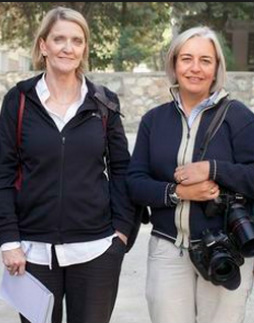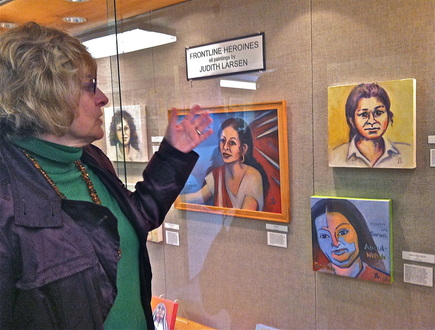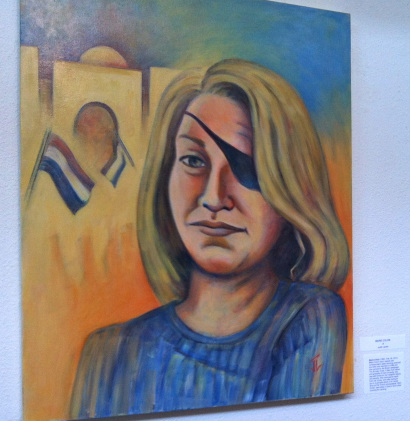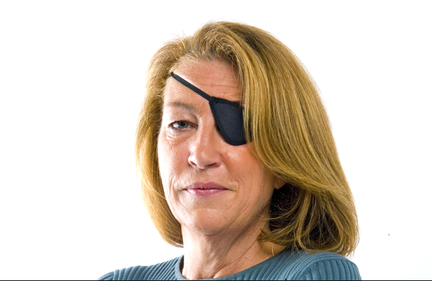Fearless Reporters: Remembering the Female Journalists
Artist Judith Larsen depicts slain journalists in" Frontline Heroines"
Words, photos, videos & concept by Jennifer Karchmer
All oil paintings shown here by Judith Larsen
Artist Judith Larsen depicts slain journalists in" Frontline Heroines"
Words, photos, videos & concept by Jennifer Karchmer
All oil paintings shown here by Judith Larsen

Anja Niedringhaus (right) with Kathy Gannon, both experienced AP war correspondents. (Source: Winnipeg Free Press).
|
Editor's Note: On April 4, 2014 AP photojournalist Anja Niedringhaus, 48, was killed by an Afghan policeman who opened fire on her and fellow AP journalist Kathy Gannon, 60, who was wounded. The journalists were in a town called Khost, covering Afghanistan's presidential elections. Through an email, artist Judith Larsen said: "As of today I sadly have another heroine to add to the Frontline Heroines series." Larsen's exhibit "Frontline Heroines" will be featured at the University of Washington School of Social Work from Aug. 25-Dec. 12, 2014. The gallery is located on the first floor of the School of Social work at 4101 15th Ave. NE, 98105, adjacent to the UW campus in Seattle. |
Click here to go to the photo gallery "Frontline Heroines" by Judith Larsen
|
(Above video) Larsen discusses her portrait of Russian journalist Anna Politkovskaya, who was killed in Moscow in 2006.
Veteran war correspondent Marie Colvin: "WHY do I cover wars? I have been asked this often in the past week. It is a difficult question to answer. I did not set out to be a war correspondent. It has always seemed to me that what I write about is humanity in extrems, pushed to the unendurable, and that it is important to tell people what really happens in wars – declared and undeclared." -- from her New York Times editorial, April 22, 2001. Sources for further information on press freedom:
Committee to Protect Journalists Doha Centre for Media Freedom International News Safety Institute International Women's Day Reporters Instructed in Saving Colleagues (RISC) Reporters Without Borders WBEZ Worldview: Marking the International Day to End Impunity (Nov. 23) |
On a Friday morning in October 2013, Larsen met me at the Center for an interview. While we walked among the pieces, she pointed out nuances in her paintings and shared the inspiration that led to her work.
"These women gave their lives in the name of freedom of speech," she said, as we looked at several pieces in a large display case and walked to the main exhibit room where the remaining were arranged. Larsen had some false starts. In an attempt to get the paintings just right, she ripped up her canvas and started from scratch for a few of the pieces. The portraits of Anna Politkovskaya and Marie Colvin are particularly important to her as she felt a responsibility to keep the women's stories alive. "It was overwhelming at times," Larsen said. "I felt like they were saying to me, "We're counting on you," to tell our stories. Politkovskaya, a fearless Russian journalist who regularly received death threats, was shot and killed in her Moscow apartment building in October 2006. She had reported for the newspaper "Novaya Gazeta" from Chechnya and investigated wrongdoings of the Russian state. [See video at left]. Colvin, a veteran war correspondent originally from Long Island, NY, was killed by shellfire while on assignment in Homs, Syria in February 2012. She was 56. One of Colvin's last broadcasts was a CNN interview on Feb. 22, 2012. "I saw her on CNN being interviewed by Anderson Cooper. Then I started painting," Larsen said. Colvin, also a fearless journalist who pursued the human angle to war stories, wore an eyepatch on her left eye due to a grenade blast on April 16, 2001 while covering conflict in Sri Lanka. In fact, Colvin penned this New York Times editorial a week after her injury. It begins: "‘The shot hit me. Blood poured from my eye – I felt a profound sadness that I was going to die." |
""These women gave their lives in the name of freedom of speech," Judith Larsen, artist & journalist
|
According to Reporters Without Borders (RWB), the international nonprofit that protects the press, 76 journalists were killed on the job in 2013. Syria was considered the deadliest nation for journalists with 11 deaths that year. But 2012 was a particularly brutal year for media workers in conflict zones with 88 deaths reported worldwide, according to RWB. Somalia was the most dangerous for journalists in 2012. RWB conducts fact-finding missions and relies on first-hand reports from correspondents in more than 150 countries worldwide to determine which journalist deaths are work-related.
Another media advocacy group that tracks journalist deaths, the Committee to Protect Journalists (CPJ) based in New York, reports similar numbers last year with 70 journalists deaths considered "motive confirmed." Through its investigation, CPJ determines whether a journalist was killed "in direct reprisal for his or her work; was killed in crossfire during combat situations; or was killed while carrying out a dangerous assignment such as coverage of a street protest." The photo gallery of Larsen's portraits show many female journalists who were gunned down, murdered and assassinated for their work uncovering important stories that otherwise would be censored. Most alarming about journalist deaths is the impunity related to the killings. In other words, murdering a journalist is a form of censorship and according to CPJ 9 out of 10 cases go unpunished. CPJ has launched a global campaign "Speak Justice: Voices Against Impunity," and UNESCO has declared November 2 the International Day to End Impunity. Meantime, threats against women working in media are also troublesome. INSI (International News Safety Institute) recently reported findings from a survey on women journalists' experiences on the frontlines. INSI found "nearly two-thirds of respondents had experienced some form of intimidation, threats or abuse in relation to their work, and that the majority of these threats occurred in the work place." The International Women’s Media Foundation (IWMF) at the United Nations in Geneva and New York helped administer the survey and create the final 40-page report: "Violence and Harassment against Women in the News Media." [You can read the the full report in English here: http://newssafety.org/uploads/IWMF.FINALA.PDF] Through the portraits, Larsen tries to capture, even on a small scale, the women's humanity and emotions -- what has led to their drive in telling important stories of war, conflict and culture. While her exhibit is back at her home in Edmonds, Wash., she is looking into applying for financial grants to help transport and show the artwork at larger institutions, such as the Smithsonian in Wash, DC., to keep these women's stories alive. If you missed the exhibit last year, "Frontline Heroines" will be shown at the University of Washington School of Social Work from Aug. 25-Dec. 12, 2014. Published by Jennifer Karchmer April 5, 2014
|


